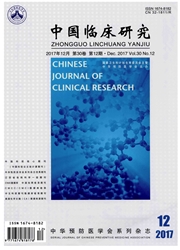

 中文摘要:
中文摘要:
目的:探讨心力衰竭高血压、年龄、糖尿病和脑卒中(包括一过性脑缺血)(CHADS2)评分及改良CHADS评分对心房颤动(房颤)射频消融术后复发的预测价值。方法对2010年7月至2012年3月在我院行射频消融术的93例房颤患者追踪随访12个月,术后1,3,6,9,12个月行12导联心电图或长程心电图检查,结合临床症状及心电图检查结果将其分为复发组(n=40)和未复发组(n=53),采用单因素和多因素分析消融术后房颤复发的危险因素。结果93例房颤患者中持续性房颤35例(37.63%),随访12个月时复发40例(43.01%)。房颤复发组与未复发组在平均年龄(P<0.01)、年龄>70岁(P<0.05)、病史(P<0.05)、房颤类型(P<0.01)、左房内径(P<0.001)、左室射血分数(P<0.05)、血细胞比容(P<0.05)、是否伴心力衰竭(P<0.05)、是否伴高血压(P<0.01)、是否伴糖尿病(P<0.05)、是否有一过性脑缺血或脑卒中史(P<0.05)、术后是否服用血管紧张素转换酶抑制剂和血管紧张素Ⅱ受体拮抗剂(ACEI/ARB,P<0.01)、术后是否服用Ⅲ类抗心律失常药(P<0.05)、CHADS2评分≥1(P<0.001)等方面差异有统计学意义。logistic回归分析发现,病史、房颤类型、左房内径、CHADS2评分≥1为房颤术后复发的独立危险因素(病史长短:OR=1.16,P=0.020;左房内径:OR=1.17,P=0.025;房颤类型:OR=3.34,P=0.050;CHADS2评分≥1:OR=5.93,P=0.019)。进一步分析发现,CHADS2评分≥2、改良CHADS评分≥1、改良CHADS评分≥2亦为房颤术后复发的独立危险因素(CHADS2≥2:OR=5.42,P=0.028;改良CHADS评分≥1:OR=6.64,P=0.015;改良CHADS评分≥2:OR=7.32,P=0.002)。截断点分析显示,CHADS2与改良CHADS均≥1时对房颤消融预后的预测价值最高,对CHADS2评分≥1与改良CHADS评分≥1预测房颤消融预
 英文摘要:
英文摘要:
Objective To determine the value of cardiac failure, hypertension, age, diabetes and stroke 2 (CHADS2) and modified CHADS score to predict the recurrence of atrial fibrillation (AF) after radiofrequency catheter ablation. Methods A total of 93 consecutive patients with nonvalvular AF who received catheter ablation in our department from July 2010 to March 2012 were enrolled in this study. They were all followed up for at least 12 months. Electrocardiography or 24-hour Holter monitoring was conducted in these patients in 1, 3, 6, 9, and 12 months after ablation. They were divided into AF recurrence group (n=40) and AF recurrence-free group (n=53) according to clinical manifestations and electrocardiographic results. Univariate and multivariate analyses were conducted to find which variable was related with the risk of AF recurrence. Results There were 35 cases (37.65%) of persistent AF out of 93 AF patients, and 40 of them (43.01%) had AF recurrence in 12 months after ablation. Univariate analysis revealed that average age (P〈0.01), age〉70 years (P〈0.05), medical history (P〈0.05), type of AF (P〈0.01), left atrial diameter (LAD, P〈0.001), left ventricular ejection fraction (P〈0.05), hematocrit (P〈0.05), accompanied with congestive heart failure (P〈0.05), hypertension (P〈0.01), diabetes (P〈0.05), prior stroke or transient cerebral ischemic attack (P〈0.05), post-operative administration of angiotensin converting enzyme inhibitor or angiotensin Ⅱ receptor blocker (ACEI/ARB, P〈0.01) or class Ⅲ antiarrhythmic drugs (P〈0.05), and CHADS2 score ≥1 (P〈0.001) were significantly related with the outcome of nonvalvular AF after ablation. Logistic analysis showed that medical history (OR=1.16, P=0.020), LAD (OR=1.17, P=0.025), type of AF (OR=3.34, P=0.050), and CHADS2 score≥1 (OR=5.93, P=0.019) were independent predictors of AF recurrence after ablation. CHADS2 score ≥2 (OR=5.42, P=0.028),
 同期刊论文项目
同期刊论文项目
 同项目期刊论文
同项目期刊论文
 期刊信息
期刊信息
